#traditional catholic stained glass images
Explore tagged Tumblr posts
Text
Amendment though, from the perspective of a scholar of Irish literature...
'Take Me To Church' fits more in the pile of Horny Andrew songs than in the pile of Political Andrew songs.
It does not, lyrically, critique the historical power of the Catholic church in Ireland. It doesn't mention the institutions, the abuse of children, the incarceration of women, the human trafficking, the censorship, the ban on divorce until 1996 or restriction of access to abortion til 2018.
It utilises the *aesthetics* of Catholicism to lend gravitas, fatalism, and overtones of death and torture and sacrifice to a song about sex.
Lyrically, the song is about a very sexually gratifying but ultimately deeply toxic relationship. It's possible that the relationship described had a femdom element, which threads through 'It Will Come Back', 'Angel of Small Death', and arguably 'Too Sweet'. It's also possible that it was written about the same physically abusive relationship as 'Cherry Wine', and is therefore darker again.
Using the aesthetics of Catholicism to talk about sex is a big part of the culture of Irish high art (and indeed the lowbrow 1909 sexts sent by post from Dublin to Trieste by our most lauded literary horndog, the bould Jim himself). It's an easy sell, too, especially if there's kink implied. The power dynamic of the confessional, the images of martyred saints and of the Crucifixion, the supplication and guilt and ecstacy of absolution and sacrament. Hell, even the convergence of kink aesthetics with goth aesthetics, which themselves are very Catholic, and owe much to the work of Anne Rice, an Irish-American Catholic who couldn't have been more obsessed with sex, power, and death if she tried.
This was once very political. Oh, you're going to tell me who I can fuck, when, and, for what purpose? Watch me use your aesthetics as metaphors for very explicit business! Deviant business, even!
Nevertheless, this conflation of sex, death, and the High Church is no longer subversive in an Irish context. In our literary tradition we have done this for over a century. It's all over our novels and our poetry. This literary tendency doesn't work as a critique of the Church on its own, because it says very little about the conditions of repression and oppression which the institution created. It also was not written during the period when Ireland was a theocratic hellhole where women were locked up for premarital sex and children born out of wedlock were subject to for-profit theft. If anybody could go there, lyrically, it's my boy Andrew. But he didn't go there in his breakout hit.
TMTC is, in an Irish context, subversive only in its music video, intertextually giving itself a queer reading. The music video remains political because it created a connection between the repression of the Irish 20th century on all carnal matters and the present day repression of queerness in other parts of the world.
The actual lyrics of the actual song though? That's just what literary minded Irish boys do when they're expressing intense horniness. They dress it in incense and stained glass. They make it about worship and suffering and "a hymn rising in the dim cloisters of my heart", to quote one of Joyce's spicy letters.
It's a masterpiece, the finest distillation of this tendency of the 21st century so far. It might even be the zenith of it, the last ecstatic cry of a tendency we no longer need.
But it isn't inherently political. Not on its own. For politics, Hozier has plenty of other great songs.

🙃 Regular reminder that while Hozier has amazing love songs, he is ALSO very outspoken about his leftist politics, specifically anti-fascism, anti-racism, reproductive rights, Palestinian rights and more.
Take Me To Church and Foreigner’s God are scathing critiques of organized religion, specifically the Catholic Church and the colonization of Ireland.
Moment’s Silence is about oral sex but it’s ALSO about how that specific sexual act is often distorted to a show of power rather than that of love.
Nina Cried Power is an homage to various (mostly Black) civil rights activists from the US and Ireland and a call to follow their path.
Be criticizes anti-migrant policies and Trump and his ilk.
Jackboot Jump is about the global wave of fascism and about protest and resistance.
Swan Upon Leda is about reproductive rights and the violent colonial oppression of Ireland and Palestine.
Eat Your Young is about the ruinous way the 1%/capitalism and arms dealers prioritize short-term profit over everything else to the detriment of the youth/99%
Butchered Tongue is about Irish and other indigenous languages being suppressed and erased by imperial powers.
If any of the above surprised you, please, please delve deeper into Hozier’s music, you’re missing such an important part of his work.
75K notes
·
View notes
Text
Verdier, energy and freedom in art
Recently I made my way to London to visit the royal academy of the arts and a collection of private galleries, with the aim of expanding my understanding of contemporary art movements. After a short time I found myself visiting the Waddington Custot gallery which I decided to go into after seeing some impressive abstract paintings through the window. Once inside I found out that the whole building was being used to display a collection called “retables” by the French abstract artist Fabienne Verdeir. Every painting was composed of three canvases placed together side by side and held together by paint that appeared to have been thrown on it. Furthermore, the two outer canvases on each work were tilted inward to replicate the appearance of an altarpeice. I was absolutely fascinated by these art works with my favorites being a three piece installation entitled “Ode to life 1,2 and 3” which had each been placed on different walls in a small room echoing the triality of the retables. What most astounded me about these works was the level of energy and motion the artist managed to capture in the paint, as I personally often attempt to capture similar expressions of dynamic existence. Whatsmore I found the reconstruction of religious imagery in the use of the retables to be a genius way of symbolizing the way art has left the control of the church while still admitting the heavy influence faith has had on the way artists express meaning in their works.
Verdiers works are relatively unique, as she doesn't attempt to create an image but rather she focuses on the capture of energy and movement. Typically Verdier uses incredibly large brushes, suspended over canvas to create her paintings because in her own words “the brushstroke must be free” in order to properly express the “movement of life and the dynamism of form”. Personally, I think that Verdier best expressed this “movement of life” through the “Ode to life installation”. This installation (of three works) stood out to me most for two reasons; first Verdiers color choices, and secondly the sense of dynamic speed Verdier created with her brushstrokes. To elaborate, the color choices in the Ode to life collection stand out because of the stark contrast they create between the brilliant crimson red and the metallic gold and blue that creates a more muted background. The contrast created by this color combination made the ode to life paintings stand out far more than other works such as dans la forêt which are less expressive in their contrast. Furthermore Verdier created a sense of speed to the ode to life works by not letting the paint build up into such thick layers as she has done in other works such as “the roots of earth”. This much less textured appearance creates the impression that the brush was moving quickly, not being given time to pour paint onto the page, allowing the viewer to find an increased sense of dynamic speed. Therefore In my opinion when it comes to capturing the “movement and spontaneity” of life the best works in the retables collection is absolutely the “Ode to life” collection.
A retable is a type of religious decoration associated with the catholic church that used paintings, stained glass and sometimes even carvings to depict stories from the bible. Retables were commonplace in historical churches as it was common for the congregation to be illiterate and unable to really understand the bible as it was typically read in Latin by catholic churches, so retables would help teach the bible through visual storytelling. Verdier has taken influence from this, in an interview with Elephant magazine she described her inspiration, saying “those painters were obligated to depict liturgical subjects to evoke the mysteries of life, I thought it would be interesting to adapt the almost cinematographic construction”. From this we can see that Verdier is working in dialogue with the artistic traditions of the past, however it gives me the impression that Verdier feels that religion itself is insignificant in the modern era. This is reaffirmed somewhat when later in the interview she claims to be “looking forward to depicting the altarpiece of our lifetime”. Although this sentiment is not particularly flattering of organized religion, I struggle to see it as a criticism of faith. Rather with this collection we can see Verdier take influence from history and use it to express her own individuality while challenging those who engage with her art to question their own feelings about religion and if it has lost its place to a world more interested in individuality.
In my opinion, the “retables” collection is a collection of modern masterpieces. Whatsmore its a collection that seriously resonates with my own beliefs about art, and what it means to be a creative. To me a true art work has to fulfill two criteria; firstly an artwork must capture the energy and motion that is integral to life, secondly an artwork must represent the zeitgeist of its age(such as how Da Vinci's final supper represents how the catholic church influenced high renaissance culture ). To me, Verdiers “retables” brilliantly fulfill both these criteria, the motion captured within the collection perfectly embodies the motion of life. Furthermore Verdiers use of the retables motif to symbolize the dwindling impact of religion in place of art and new media brilliantly explores the changing influences over life in modern society. Therefore I view the retabels collection as a series of modern masterpieces
Mcnay, A. (2016) Fabienne Verdier: I am an intreped woman, a bit of a rebel maybe. Available at: https://www.studiointernational.com/fabienne-verdier-interview-i-am-an-intrepid-woman-bit-of-a-rebel(Accessed: 04/11/24).
Hallström, S. (2024) Fabienne Verdier is Letting Go with Every Stroke She Paints. Available at :https://elephant.art/fabienne-verdier-is-letting-go-with-every-stroke-she-paints/ (Accessed: 04/11/24).
Verdier, F. (2024) Ode to life 1,2 &3 [Oil on canvas]. London, Waddington Custot (Viewed: 15/10/2024).
Verdier, F. (2024) roots of earth [Oil on canvas]. London, Waddington Custot (Viewed: 15/10/2024).
Hallström, S. (2024) Fabienne Verdier reviewed in Frieze. Available at: https://www.waddingtoncustot.com/news/366 (Accessed: 04/11/24).
1 note
·
View note
Text
Aix-la-Chapelle Cathedral: Aachen, DE
I chose to study Aix-la-Chapelle Cathedral, known as the Aachen Cathedral in Aachen, Germany, because it was the first cathedral I have ever visited. I wanted to learn more about the concept of cathedrals and what makes the city of Aachen, Germany, so unique.
The Aix-la-Chapelle Cathedral, known as the Aachen Cathedral in Aachen, Germany, was part of the Holy Roman Empire during the Reformation. This region, specifically Aachen, experienced religious conflicts as Protestant ideas spread and clashed with Catholic authorities. Aix-la-Chapelle Cathedral is covered with religious paintings, sculptures, and stained glass windows depicting scenes from the Bible. During the Reformation, Protestant reformers considered the details of extravagant religious images and art idolatrous. The shift in religious authority led to the destruction, removal, and changing of religious images from churches. Artwork and pictures were critical in describing religious symbolism and facilitating religious rituals. The artwork and images shifted emphasis from extravagant rituals and traditions to simple forms of worship focused on preaching and reading scripture.
One thing that surprised me about the Aix-la-Chapelle Cathedral is that Aachen preserved or adapted current existing art to align with Protestant views during the dissident movement. Interestingly, rather than destroying the artistic scenes in stain class or paintings, they adjust the artwork to represent Protestant values.

1 note
·
View note
Text
Blog Post #3
Throughout the duration of this trip, we have been able to see most of the most famous churches in the world with lots of incredible details and design elements that are breathtaking. The Jubille Church in Rome was built in a different way than the traditional image of a Catholic Church that comes to mind when imagining one. Upon first glance at the building, one immediate difference between this church and traditional churches is the exterior appearance. The Jubille Church had a plain white colored exterior to the building as opposed to other churches that have darker colored exteriors or exteriors filled with lots of columns and details on these columns. Another major difference comes from inside the church where the visitor is brought into a place of worship that is not filled with loads of paintings or stained glass windows that you would traditionally expect in a traditional church. There was a painting of Jesus at the front of the church by the alter but the church as a whole barely had any paintings or other decorations that one would expect. Finally a big difference about this church compared to most traditional churches is the addition of a recreation center within the church grounds for the children in the surrounding community. This element is something that can sometimes be found in the States with Catholic Churches that have a school attached to it or are in towns that have a high population of kids that attend the church but is not something that we have seen at a church thus far. These differences are striking and provide a much different experience for the visitor than what they would expect from touring other churches in Rome. Without all the crazy details and elements, this church seems to provide a simpler experience for the visitor and one that almost feels like it is more important about what happens in the church during a mass or service than the appearance of the church.
0 notes
Text
How Ghost — ‘an occult, pop, satanic sort of rock ’n’ roll band’ — conquered metal and the charts

Onstage at Anaheim’s Honda Center arena, Tobias Forge is not himself.
Instead, he is Papa Emeritus IV, leader of the theatrical Swedish metal band Ghost, singing from behind a latex mask and corpse paint, dressed in religious attire or bat wings.
His persona is of Ghost’s demonic pope, preaching of war and plague like a doom prophet amid heavy guitar riffs and vivid pop melodies. Some lyrics are more prescient than fantasy, from warning of “beliefs contagious, spreading disease” on the 2018 song “Rats” to the band’s new “Impera” album, which decries empire-building in time for Russia’s brutal invasion of Ukraine.
Forge says he’s merely an observer of history and “the circularity of things,” as destructive human impulses repeat themselves catastrophically across the centuries. “Flags, pandemics, flus and dictators come and go,” he says cheerfully. “Empires come and go. It’s always in circles, because at the end of the day we are dealing with humans.”
Forge, 41, is out of costume and sipping coffee at his West Hollywood hotel after a night of hard rock spectacle, with pyro eruptions and a big stage meant to convey threatening Gothic arches and stained glass. Offstage, Forge is less explosive, dressed in a treasured 1988 Candlemass tour T-shirt, his light auburn hair short and swept upward on top. He’s a thoughtful interview and quick with a joke, a family man with a wife and fraternal twins back in Stockholm. The previous night’s concert in Orange County was the final stop of a co-headlining arena tour with the Danish band Volbeat designed as a prelude to the March 11 release of the band’s fifth album, “Impera.”
During rehearsals ahead of the tour, Forge got “a very mild case” of the Omicron virus. Then the eight other touring members of the band tested positive, along with four crew members. “The whole band had it at the same time, so we just had COVID rehearsals,” he says. The tour happened as scheduled, and Ghost will be back in the U.S. later this year.

The band’s last record, 2018’s “Prequelle,” earned a Grammy nomination for rock album and hit No. 3 on Billboard’s Top 200. The band counts Metallica and Dave Grohl among its high-profile fans, and attracts a multigenerational rock audience, from kids in baby pope gear all the way up to older fanatics nostalgic for ’70s shock rock.
“Ghost has a diverse audience, which I love to see, especially for metal,” says Sammi Chichester, managing editor of Revolver Magazine, a close observer of the metal scene.
Forge is able to find pop hooks even as he mines his own low expectations for mankind. As a result of that catchiness, Ghost has been controversial among certain extreme-metal tastemakers. “It is a routine topic — metalheads love to argue,” says Chichester with a laugh.
The music tends to be more engaging than depressed, despite the ominous religious imagery.
“The lyrics are not about God. They’re about man,” says Forge. “We are, at the end of the day, an occult, pop, satanic sort of rock ’n’ roll band meant to entertain a group of people who are already down with that stuff.”
Any discussion with Forge quickly reveals him as a pop music obsessive, as he casually references Leonard Cohen, the Bangles and the primitive weirdness of the Shaggs. He’s not your typical high priest of metal. “In my adolescence, I was completely a death metal/black metal person in action and message,” he says. “But I always listened to a lot of other things. And that materialized in whatever music I was writing.”
Ghost was created in 2006 with Forge’s recording of a track called “Stand by Him,” built on a slippery metal riff and roots firmly planted in Scandinavian black metal. The music that followed rarely strayed from a growling metal core but showed surprising flourishes from the beginning, from busy keyboard melodies to delicate acoustic guitar.
The band arrived with a fully formed image that adopted a demonic, bizarro take on the Catholic tradition, accented with Gothic flair and comedy. Forge stood at the microphone in the role of a series of demonic popes called Papa Emeritus (Nos. I-IV), in flamboyant papal attire, with a band of musicians called Nameless Ghouls in silver masks. (The Ghouls now appear in what look like gas masks from a dystopian future.)
Forge, who is the band’s only consistent member, kept his identity hidden behind facepaint and pseudonym until he had to reveal his real name during an unsuccessful 2017 lawsuit by four ex-members of Ghost over back pay.
“Impera” was recorded last spring and summer, after the original plan to work with an American producer in the U.S. was canceled as the coronavirus crisis dragged on. Instead, Forge reunited with Swedish producer Klas Åhlund (Ghost’s collaborator on 2015’s “Meliora”), and he took his time composing new songs.
He sketched out a melody for the album’s closer, a nearly seven-minute prog epic called “Respite on the Spitalfields,” on the small electric piano in his daughter’s bedroom. “Twenties” emerged as a frantic chronicle of greed and oppression, in the form of a “demagogue sect leader speaking down to his followers in utter contempt,” he says. The sneering, catchy ’80s rock of “Griftwood” was inspired by former Vice President Mike Pence and leaders who wield the Bible as a means to political power.
The album also arrives as a pair of successful TV series — “Cobra Kai” and “Peacemaker” — have reintroduced an earlier generation of pop-metal to the masses, with prominent use of ’80s hits by the likes of Twisted Sister, Faster Pussycat, Hanoi Rocks, Ratt, Mötley Crüe, Scorpions and Def Leppard.
Ghost isn’t a throwback to the hair-metal era but does share a taste for hooks and melodrama. Forge hasn’t seen “Peacemaker” but spent quality downtime at home in Sweden watching “Cobra Kai” with his teenage daughter. “That series is a slam-dunk,” he says of the show, which continues the story of the “Karate Kid” movies. “And the music is great.”
The Ghost mastermind admits to nostalgia for what was commonly known as “album-oriented rock,” the mainstream rock category epitomized by Journey, Foreigner, Boston and other ’70s and ’80s FM radio stars. “I’m a huge fan of AOR bands,” says Forge, describing the genre as “smart divorce rock played by older men with mustaches who have gone through a little bit in their lives.”
Forge was raised in Linköping, Sweden, by a single mother and indoctrinated into rock early, by a brother 13 years older. Before he was 10, Forge was buying English and German rock magazines he couldn’t read, and absorbing as much metal, punk and classic rock as he could.
As a teenager, his tastes grew even darker and more extreme, as he discovered underground metal rising from Europe and America — then turned away from anything new in the genre after 1994, when he sensed things becoming too polished, spoiling the scary lo-fi sound and image he loved.
As Ghost itself grows more sophisticated in its sound and approach, Forge knows some longtime fans wish he would return to the band’s original recipe. Forge understands the feeling, and admits that he’d love nothing more than to produce new albums from bands of his youth so that he could force them back to an earlier sound.
He says he wants to satisfy fans while also challenging them. “I deal with that professionally in one way, and as a fan in another.”
Forge fully appreciates the intense feelings a music fan can have about a recording artist. Evolution is not always welcome.
“That has a lot to do with the type of personalities that are drawn to the world that we’ve been talking about: metal, hardcore, comic books, sci-fi — it’s a retreat, a safe place of order, organization, knowledge. This is the world that you hide in after school. And now there’s someone coming in there trying to … evolve? It’s disruptive.
“It’s not right or wrong. The future is what we don’t know, as much as it hurts.”
LA Times
108 notes
·
View notes
Text

[image text: reply from tumblr user @theduchessunseen Belos is def Catholic, look at his robes and the palace has stained glass windows just like a cathedral]
in response to this post about Hunter being religiously abused
his whole deal as emperor definitely borrows a lot of catholic imagery, so it’s very possible. i think you could justify that reading p easily with what’s in the text. personally though i disagree just based on the other circumstances of his context. the time and place he’s from makes it imo a lot more likely that he’s a puritan.
especially given the recent info we’ve gotten, i don’t necessarily think that the imagery he uses to cultivate a sense of power and majesty and authority must necessarily reflect his own true feelings or beliefs. it seems increasingly unlikely that it does, actually. i think this is a man who will just do or say whatever he thinks will get him what he wants and freely borrows from all kinds of sources.
(also, i am FAR FROM an expert here, but to my knowledge some protestant traditions do also use stained glass, esp ones like the anglican church which are fairly closely linked to catholicism, and from which puritans sprang, so it’s not like he would be entirely unfamiliar w the concept if he were a puritan anyway.)
#replies#the owl house#emperor belos#someone who knows more about the nuances of the puritan reformation movement and migration tell me about this
15 notes
·
View notes
Text
Blessed Karl of Austria - An Emperor of Peace and Shining Example of Christian Kingship

Each one of us, as human persons, has a deep and lasting desire for virtue. Though this desire to conform one’s life to the good might be distorted by ignorance or completely perverted by vice, it cannot be erased from the human heart. It is this insight into the life of the human person that is the foundation of our Civilization, the guiding principle of the West. And because it is forgotten again and again, pushed aside by the cares and concerns that poison our world, Divine Providence raises heroic witnesses before the community of Mankind, to remind us what each and every one of us are capable of doing. For our own age, we have been gifted with the life of an amazing hero, Karl of Austria, to embody for us the call to virtue.
The life of Blessed Karl stands in opposition to the nihilism of our current cultural decline. From his youth he formed those habits of soul which following the tradition of Aristotle we call the moral and intellectual virtues, building on the supernatural gifts of baptism, Faith, Hope, and Divine Charity. So ingrained in his person did these become that even in the most desperate crises of his life, he always acted in accord with this second nature of heroism. And like the radiant image of a stained-glass window, he illumined and inspired the lives of all around him. His constant courage maintained the morale of his soldiers, fighting for their beloved homelands on the front lines of the fratricide of the human race. His temperance encouraged the moderation which allowed his people to survive the devastating famines caused by the war’s blockade, his justice in enacting reform throughout the realm over which he ruled inspires confidence in the rule of law even to this day. And above he had the prudence to orient his life to the Love of God, in whom he had imperishable Faith and Hope, which itself has inspired a restoration of devotion that would strengthen the resolve of martyrs long after his death.
And yet perhaps nowhere is this virtue more visible than in his undying mutual friendship and love shared with his wife, Servant of God Zita of Bourbon-Parma. So integral to their common life of virtue was this beautiful relationship that we celebrate the anniversary of their wedding as the feast day of Blessed Karl. That day in 1911 he told Zita, “Now we must help each other get to Heaven,” a life-long journey through many trials and tribulations. And this virtuous love has born fruit through many subsequent generations, especially in the work of their first son Otto, who came to embody the very virtues both his father and his mother displayed in their life together.
Today we see these lives as something extraordinary, to be able to so form one’s soul to virtue that one become virtuous in his very nature seems to be reserved to a very few individuals. As a political and social community we despair of the good, we call our despondent view of human nature “realistic” and imagine that settles the question. Yet the reality is that while few of us called to act with such courage as to save an entire empire from collapse or the endurance to live in painful exile separated from our homeland and even our children, we are all called to develop those virtues in our lives, that when the extraordinary time comes, the ordinary man can live the extraordinary life of virtue that he is always meant to live. The beauty of the life of virtue as lived by Blessed Karl is, as expressed by Catholic writer Ernst Jünger in On the Marble Cliffs:
The presence of a good master reveals to us our true desires and enables us to be ourselves. His noble image lives deep in our heart because in him we first discern that of which we are capable.
The noble image of Blessed Karl is truly an icon of Our Lord Jesus Christ, who rules not by terrible violence and coercion, but by installing in the lives of the citizens of His Heavenly City the grace of True and Everlasting Life. May our lives ever conform to the life-giving rule of the Emperor of Heaven and Earth, following the example of the virtuous life of his Servant, Blessed Emperor Karl.
-Ritter von Donau
source: https://thewarforchristendom.com/2019/10/21/blessed-karl-of-austria-a-virtuous-hero-for-our-age/
16 notes
·
View notes
Text
FOMA 38: Five Examples of Sacral Architecture in Kaunas
In June 1940, Soviet army entered Lithuania. This was a beginning of a 50 year long occupation. Catholic Church was one of the biggest enemies of the Soviet Union. Because of atheist policy, churches and other sacral buildings of all confessions were being closed and turned into warehouses, sport halls and galleries, therefore ignoring their architectural and cultural heritage value.
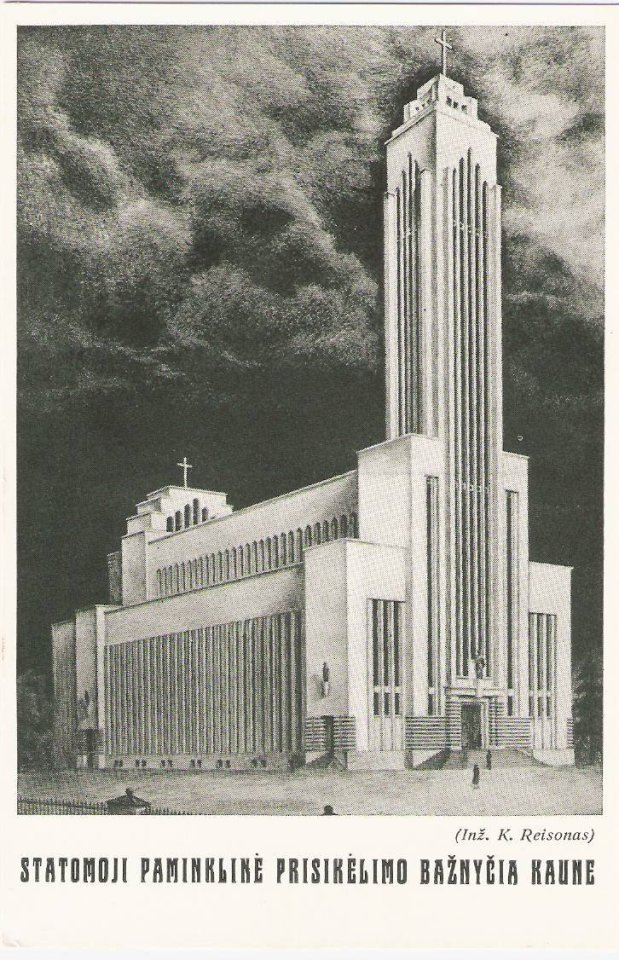
The poster with the “Monumental Church of the Resurrection in Kaunas” from 1940s. | Photo via Lietuva Senose Fotografijose
A lot of valuables were stolen, but the largest damage for the buildings was done by the weigh of goods stored on wooden floors – it crippled the walls, meanwhile the humidity and rainwater which leaked through the holes in the roofs damaged the interiors of abandoned churches. [1]
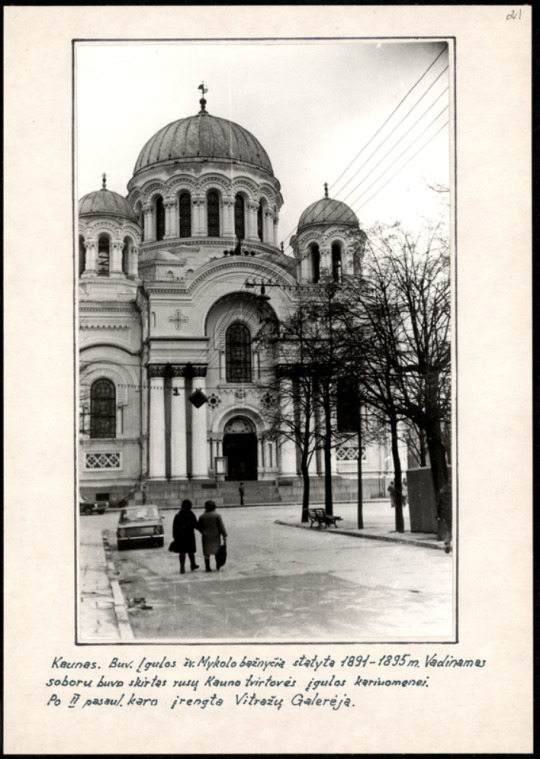
St. Michael Archangel Church was transformed into the Gallery of Sculpture and Stained Glass. | Photo © Nacionalinis Čiurlionio dailės muziejus
A choice to turn a church into a warehouse is rather interesting, since a warehouse had a symbolic meaning in the Soviet Union. Some researchers believe that converting churches into warehouses “was not the abolition of the holy but, so to speak, its replacement. The warehouse is just as ideal an order in the material world as the church is in the spiritual world. The warehouse is a materialist church, but instead of collecting people who are seeking in prayer an exalted form of the soul, it houses a multitude of objects that have found a precise inventoried form.”[2]

Vilnius Cathedral Basilica in 1847 | Lithography via Katedra.lt
Nevertheless, according to various data from 1953 to 1959 nearly 15-20% of churches were closed while some of sacral buildings went through radical transformations. Vilnius Cathedral Basilica (1783) by Gucevičius was closed in 1949. During 1950 sculptures of saints, which were on the rooftop were removed and destroyed. Since the Cathedral was closed a lot of artifacts were stolen while the interior was ravaged. The Cathedral become part of the Museum of Art and was in1956 transformed into a gallery. The building was returned to the Catholic community in 1988.

Vilnius Cathedral Basilica in 1950 | Photo © S. Simanskis
A synagogue of Kulautuva constructed by Trakman (1935) was turned into the warehouse. In 1967−1968 the building was reconstructed and masoned, so that it could be used for a library and a cultural centre.
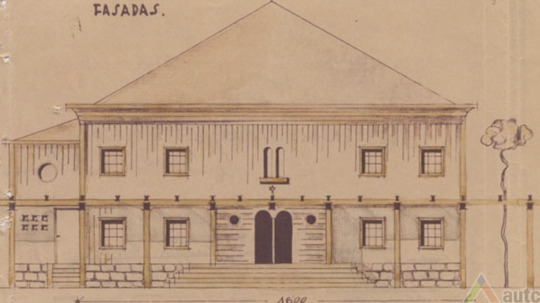

The original constructions of the synagogue were uncovered in 2016 and was due to its poor condition demolished. | Photo via autc
Kaunas and Kaunas District are well-known because of the modernist buildings that were built during the Interwar Period. Five examples of Kaunas modernism – five sacral buildings - that were pushed to the politics of the oblivion in the Soviet times and are celebrated as architectural and cultural heritage today will be presented in this edition of FOMA.
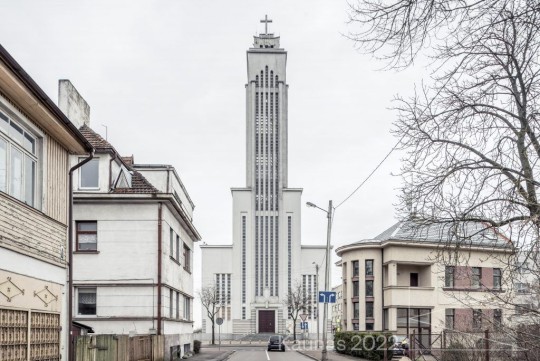
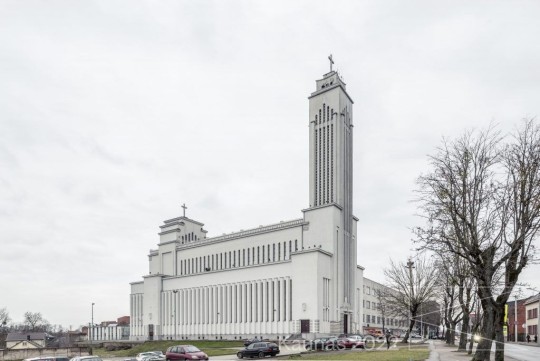
Christ’s Resurrection Church had a flat roof, what was not common for catholic churches at the time of construction. | Photos © Lukas Mykolaitis
The Christ’s Resurrection Church was designed by Karolis Reisonas in 1929 as a 82-meter tall spiral tower crowned by a 7 meter tall statue of Jesus Christ. However, this project was too pricey and not very well accepted by the people of Kaunas, therefore abandoned. A new project was inspired by modernist spirit and designed in 1932. It was believed that the new church would become a monument of XX century architecture because of its contemporary style, advanced construction and quality materials. Its size was also extraordinary and exceptional in the context of the Baltic States.
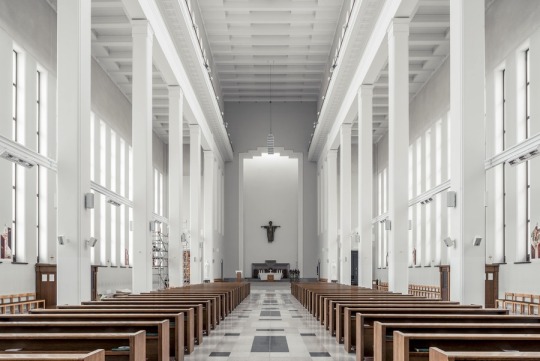

Local granite was used for the construction, and the window frames and doors were made of oak. | Photos © Lukas Mykolaitis
The construction of the church was complicated because of lack of funding. Therefore the community engaged in the collection of donations for the church. In 1938 the walls were masoned and the roof was covered in concrete. In the spring of 1940 main construction works were completed, but when Lithuania was occupied by the soviets, it stopped and the building was confiscated. During the second world war the church was used as a paper warehouse.

The inside of the church was reconstructed, adapting it to the needs of the Kaunas Radio Factory. | Photo © Kauno miesto muziejus
In 1952 a decision was made to turn the church into the Kaunas Radio Factory, later named Banga. The inside of the church was reconstructed, adapting it to the needs of the factory: three stories in the side naves and five stories in the central nave were constructed. Crosses were removed, the chapel was demolished and large industrial windows were installed.

Minija-4 produced 1967-1973 in Kaunas. | Photo © Kauno miesto muziejus
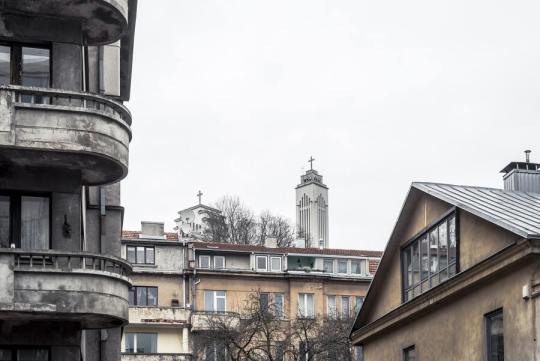
Since the opening in 2004 the church has become the dominant landmark within the cityscape. | Photos © Lukas Mykolaitis
During 1930s Vaclovas Michnevičius designed a neo-gothic church for the Evangelical and Reformed community in Kaunas and the project was not built since its design didn’t fit well with its surroundings.The other project designed by Karolis Reisonas represented current modernist trends with a flat roof, smooth shape and its functionality. Narrow vertical windows added greatness to the image of the relatively small church.

Evangelical and Reformed Church looks similar to Christ’s Resurrection, designed by same architect. | Photo © Skeivys, 1956, KTU ASI archive.
The Evangelical and Reformed Church was finished in 1940 and remained unused due to the Soviet occupation. The top part of the tower was torn down, the building was nationalised and turned into the warehouse for tobacco and alcohol manufacturers. Afterwards was given to the Ministry of Internal Affairs, which adapted it for the use of special school. When Lithuania regained its independence in 1990, most of the churches were given back to religious communities, however, this case was different: since the owner of the building was an educational institution, the rules of returning the property did not apply. For nearly 20 more years the Evangelical and Reformed Church in Kaunas was used as a sports hall and a canteen, until 2019 when the church was given back to the community.
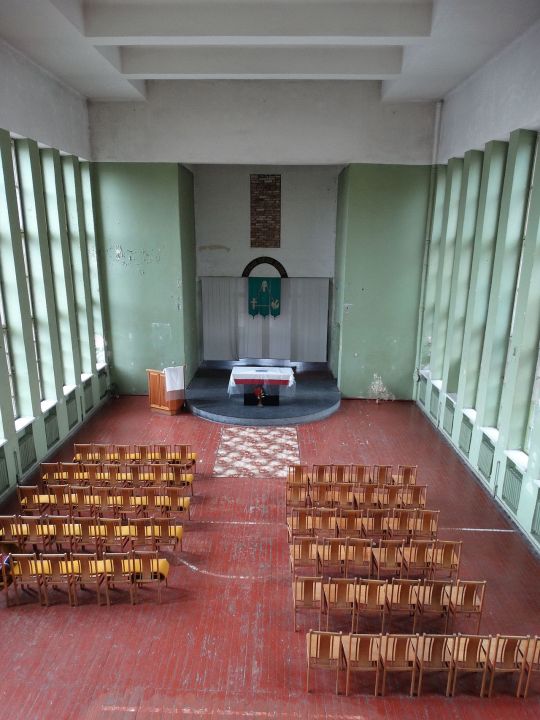
The believers were allowed to pray on Sundays. | Photo Wikimedia
Pažėrai Sacred Heart Church, a masterpiece by Stasys Kudokas, was built in a small village of Pažėrai in Kaunas district. The construction started in 1936 and was funded by the catholic community. The construction of modernist red-brick building was interrupted during the Soviet occupation. In 1967 the function of Pažėrai Sacred Heart Church changed as it was given to a collective farm and used as a grain warehouse.

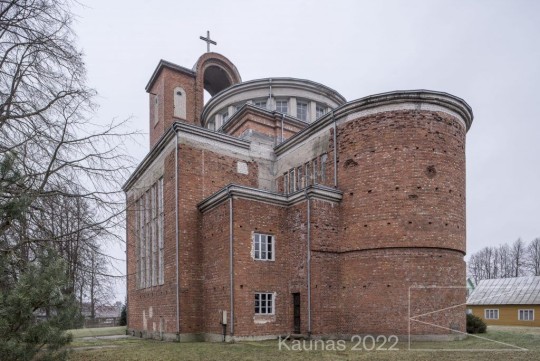

The church has two towers, with a high raised apse and the main space of the building is covered by a dome. | Photo © Lukas Mykolaitis, 2018
When Lithuania regained the independence, the church was returned to the congregation in 1991.The reconstruction began shortly afterwards and in 1997 the nearly-finished church was consecrated. The plan of the church in the form of a Greek cross has an unique, dynamic composition, and it is an example of rational modernist architecture.
Kaunas Mosque also known as Vytautas the Great Mosque is one of four remaining mosques in Lithuania. Its design reminds the mosques in Northern Africa, a compact, small-volume mosque combines historical forms with oriental motifs like an elliptical dome and a small minaret, which was never used for its traditional purpose.

Kaunas had a wooden mosque built in 1860. | Source postcard from 1940s
In 1941 the mosque was closed and robbed: its windows were smashed, carpets, furniture and ancient hand-written Quran were stolen. The ownership rights were transferred to Kaunas City Archive which turned the building into a warehouse. In 1986 the building became a library and a warehouse of M. K. Čiurlionis Museum of Art. During the soviet times murals were painted over and there are plans to recover the old murals by 2030 when the mosque will celebrate its 100 anniversary.
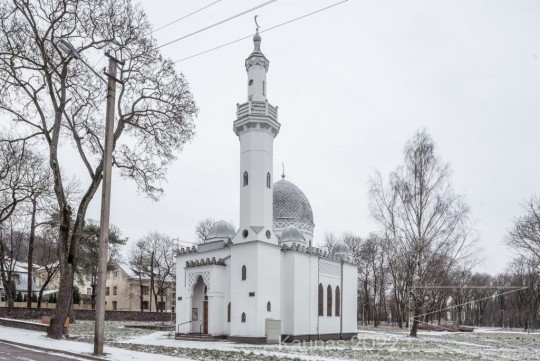
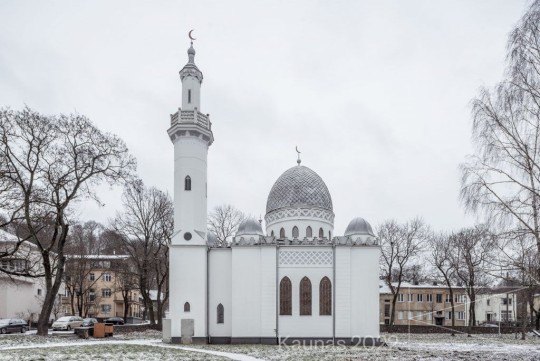
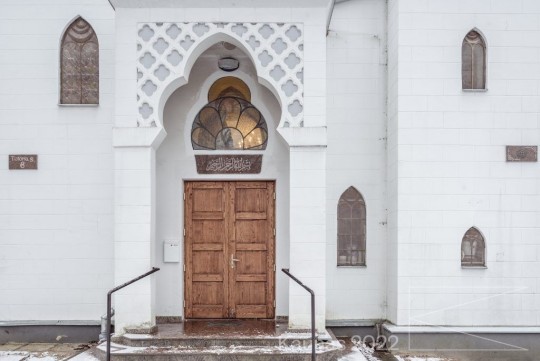
The mosque was returned to the Muslim community of Kaunas in 1989 and restored in 2007-2008. | Photo © Lukas Mykolaitis, 2017
Sacred Heart of Jesus Church in Šančiai neighborhood is a great example of modernist sacral architecture. The church is built of reinforced concrete, the nave is covered by supporting arches and the caisson shell. The exterior is minimalist and composed of regular geometric shapes: square front door and narrow rectangular windows.

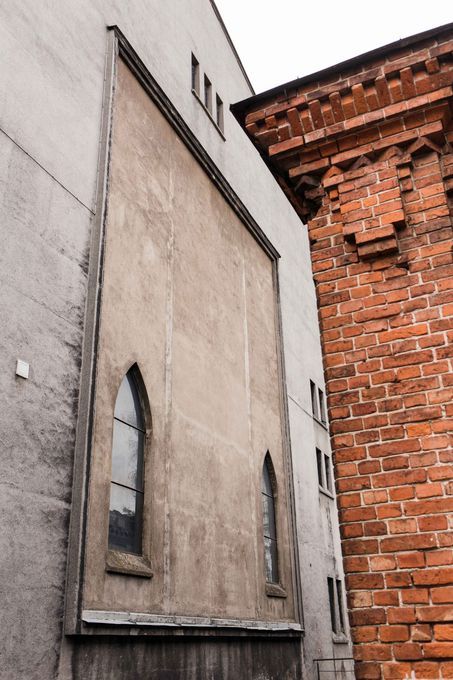
During the war, the church was damaged, instead of stained-glass window a brick wall was built. | Photo © Justinas Stonkus, 2020
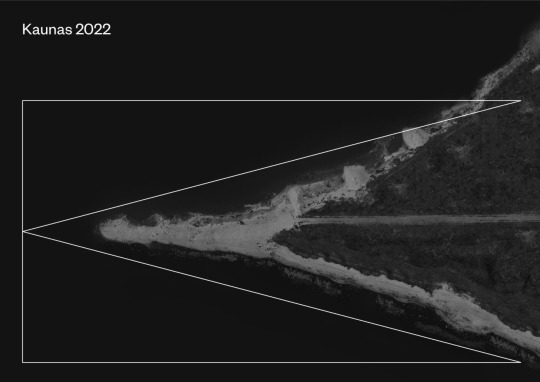
Kaunas2022 European Capital of Culture program Modernism for the Future tackles the questions of preservation, interpretation and dissemination of modernist heritage and promotes various initiatives by building owners, heritage community and cultural organizations.
[1] R. Čepaitienė. Vilniaus bažnyčių likimas sovietmečiu (1944-1990). Liaudies kultūra, 2002/5 (86), p. 32-37.
[2] M. Epstein. Russo-Soviet Topoi. The Landscape of Stalinism: The Art and Ideology of Soviet Space.ed. E. Dobrenko, E. Naiman. University of Washington Press, 2011, p. 301.
—
#FOMA 38: Ugne Marija Andrijauskaite

Portrait photo © Justinas Stonkus
Ugne Marija Andrijauskaite is a historian, who investigates social and cultural history of XX century Lithuania. In 2017 she defended her PhD thesis, which investigated urban workers and organized labour movement in interwar Lithuania. Currently she is working at Kaunas2022 European Capital of Culture program Modernism for the Future. The goal of the program is to awaken responsibility for the environment that surrounds us and create an emotional connection with the urban landscape and culture.
179 notes
·
View notes
Photo

"The next day John saw Jesus coming toward him and declared, 'Here is the LAMB OF GOD who takes away the sin of the world!'" - #GospelofJohn 1:29 . 📷: Stained Glass Image of the Lamb of God / Catholic Tradition. #CatholicPriestMedia #Catholic_Priest #SacredArtandImages
11 notes
·
View notes
Text
Emily Alexa Acosta Prof. Halbert Barton
P1: Silent Infiltration
There is a silent war that was initiated in the 1960s in the Catholic Church that is very little known about by a majority of its members, but which camp you fall under is of eternal importance. The bulk of the 1 billion in the church are unfortunately cafeteria catholics who don’t even realize that their guidance is tugged at by Trads and Modernists. Both silently have severe disdain for the other and secretly believe that the other group is ruining the church.
In the 60s the pope held what is known as the second Vatican council or Vatican II. This council was going to revolutionize the church by bringing in an emphasis on having the laity participate in church more and not have so much reliance on just priests and nuns to be the leaders of the faith. It’s the obsession of both Trads and Modernists to this day. The council ended up barely changing anything, it mainly accomplished only making how the church was run dictated in very vague rubrics and guidelines. That’s how the modernists silently infiltrated. Being that there was no longer language upheld by the Vatican as to what is allowed or rejected explicitly, modernists found wiggle room to add new things to parishes and the mass that have changed how the church looks to unrecognizable levels. It was a slow internal disfiguring of the church, done little by little through things like “voting in suggestions” on small things that simply built up for over 50 years.
Modernists are easily spotted if they call themselves “charismatics”, but trads just know them as Susan from the Parish Council. Their number one focus is voting in as many light shows, dancing and guitars to catholic mass to make it feel like the laity are included more. The Susans from the parish council are typically seen as from the boomer generation. They can range from active senior citizens that like running groups at the church to even priests, bishops or the pope. They love going up to priests and ask them things like why they wouldn’t want to be in a suit and tie instead of “those out dated weird clothes that only the mentally disturbed wear.” They also love voting themselves in to take over roles only the priest does, like touching the eucharist or reading aloud from the bible during mass. All in the name of “bigger participation”. No more emphasis on teaching theology to the faithful. What is important to them is that a person FEELS loved, and they accomplish this in only singing and dancing in front of the altar or organizing pot luck parties. Traditions of the old church are boring and don’t connect with the youth and poses a threat to a dying church that is too outdated to attract newcomers in their minds. Trads to them are also the meanest believers by their bold talk and closed mindedness. They point to Trads as the reason why the church doesn’t “catch up” to the world by adopting what is currently popular.
Trads spot each other a mile away. With their personal Latin missals in hand, men in suits and extremely modestly dressed women in their veils, they tend to run in groups and follow their favorite Father YoungTrad. They all learn latin and reject any liturgy that dates after 1962 and only attend Latin Mass. When they happily meet each other one of the first things they do is greet each other with a banter of wits. Who can out “trad” the other? It’s mainly done to gauge just how devout to the cause they are, and then to know how safely intense they can go into conversation about the faith. It starts off light mocking all things Novus Ordo. For something to be described as novus ordo is strictly an insult. The most extreme belief Trads can say to one another is proclaiming the age old motto “Salus extra ecclesiam non est”. The stereotype for trads is that they are majorly in their 20s to 30s and also range from laity to priests, bishops and the pope. These are self taught faithful that hold to the doctrines and dogmas of the church and fight all things “new” from being introduced to the church. They are almost obsessed with philosophy and theology and know their church history straight from original texts and sources. They have a fire that everything modern is ruining the faith because it abandons the beauty of the intelligence of Catholic theology for fleeting emotions.
Realizing a modern or traditional parish is as obvious as the building they’re in. Trad parishes indulge in the beauty of gothic style architecture and intricate design. Every detail of the church naturally leads the eye to flow upwards to face the one and only cross present at the front of the church all the way up to the ceilings that depict heaven. Even the altar is facing away from the congregation so that the priest can stand at the front facing God along with the crowd to offer their prayers on their behalf. His back is to the congregation because no one should be looking at him. Every eye looks at what’s most important which is either the Cross or an image of God. Every corner has a saint or an angel smiling back at you, whether in stain glass, statue or painting. To its best ability it reminds the faithful of the reality of the infinite spiritual beings that are always present with them. Trad-popular architecture is hard to distinguish from architecture that designed medieval or renaissance era churches.
In contrast, churches produced by modernist inspirations are hard to argue are churches at all. They’re more so large lecture halls whose design flow lead the eye to focus on the pulpit in which some person is going to speak from. They celebrate almost a cooking show styled “show and tell” performance mass on a table. Walls are bare and usually white or beige in the name of “humility” but that intention is drowned out by the concerts and light shows that frequent their masses. Almost nothing is around to bring to mind a single thought of heaven. They can actually go unattended because the faithful don’t even realize its a church to attend since its so easy to miss their single minimalistic cross that’s the only “holy” indicator in sight.
But silently modern churches close down and traditionalist churches keep rebuilding to expand. Too bad the bulk do not know of the riches of the faith since the modernists successfully infiltrated our catechism curriculum and stripped the altars of relics, statutes and art to make room to guitar equipment and flat beige walls. Cafeteria Catholics have no idea of the teachings of the church because modernists have voted out teachings that do not focus on how “Jesus loves everyone no matter what.” Us trads find ourselves in an engulfing sea of the Nones. But silently we’re infiltrating back. Slowly we are finding ourselves to be the only ones left that uphold the importance of faith discipline. The Boomer Susans are slowly aging out of any capacity to be present in church and seminaries are finding that only trads sign into their programs. Trads are the only ones left keeping up tithes and the only ones left signing up to catechize because we’re the only ones that even know the basics of the faith anymore. We’re careful to not be too open about being trad. If identified many priests and fellow believers know of our burning desire to undo everything from Vatican II and try to suppress our participation. But I am hopeful that the progress of the trad movement is getting our church back to where it produced the amazing saints that have changed world history and are celebrated globally to this day.
Glossary
-Cafeteria Catholics: People that identify as catholic but only like to pick and choose what they personally like that the faith teaches and rejects everything else taught. The notion is that they’re in a lunchroom choosing what to eat from the menu options.
-Trads: The slang name of people who are traditionalists in their view of the faith. They take every doctrine from the beginning of church history as fact that cannot be changed. Alternative slang term for them is RadTrad which is short for Radical Traditionalist emphasizing the extremity of their beliefs.
-Modernists: Believers that want to “modernize” the church to better reflect “world wisdom” and take away any supernatural aspects of the faith and make it more of a metaphorical mindset.
-Laity: Any Catholic that is not apart of a religious order. A catholic that is not a priest, nun, brother or deacon.
-Susan From The Parish Council: A meme character created by trads personifying the majority of the type of person a modernist tends to be. Susan is literally a grandmother that is a part of the parish council that is out of touch with what children/youth like and keeps trying to attract them with felt banners and finger paints but produces only cheesy results. Usually only their grandchildren are seen forced into their church activities and are never older than 7 in the memes. They always turn hostile to trads and exert their parish council authority to suppress tradition.
-Boomers: People born roughly in the mid 1900s (~1945/~1965)
-Latin Missals: A missal in general is essentially a “how to” instructional book on celebrating a mass. It contains the liturgy (explained further down in the glossary), prayers and readings needed for mass. Latin missals specifically give the “how to” hand guide to celebrating mass in the form before Vatican II introduced an “updated modern” version of the mass handbook.
-Father YoungTrad: Another meme character devised by trads to personify the type of person traditionalists tend to be. In stark contrast to Susan, Father YoungTrad is a fit and young priest that is extremely orthodox in his leadership and mainly only celebrates Latin mass. His parish is thriving with young people and young families that are well informed of the faith.
-Latin Mass: The name of the rite of the mass celebrated before the changes of Vatican II. Entire mass is celebrated in the official language of the church which is latin. The order of the mass that was the only way the mass was celebrated for about 1,500 years.
-Liturgy: The specific laws/rubrics on how a mass is celebrated.
-Novus Ordo: Latin for “the new order”. It is the name of the new rite of the mass that Vatican II came up with. In social circles it is used as an adjective to identify any aspect of the church/mass/or faith teaching that is not traditional and just a new invention after the 60s that have no actual church history basis.
-“Salus extra ecclesiam non est”: Latin for “there is no salvation outside of the church” and has been a slogan in catholicism since the 3rd century to signify that the catholic church is the only one true church. It is extreme because it declares that other religions including other christian denominations are not the church of the one true God. Trads say it to reinvigorate themselves to the importance of the duty they have to convert as many as they can.
-Nones: A new term coined by well known Bishop Robert Barren to identify the growing number of people that check off the “none” option whenever surveyed to identify which religion they practice or identify as.
-Seminary: The institution that men attend to become priests. “Priest school” where their graduation is actually their ordination to the priesthood. Lasts about eight years to obtain bachelors and masters degrees and includes apprenticeship at different parishes.
-Tithes: The practice of the laity to give ten percent of their salary to the church/provide support, whether financial, goods or talents.
1 note
·
View note
Text
The Constitutional Rights of the Peculiar
I remember watching all 51 days of the Waco siege in the Memorial Hall lobby at Geneva College with many of my classmates. Geneva College is affiliated with the Reformed Presbyterian Church, and the RP's practice of Christianity is mildly controversial. As Christian College students, the events vibed with us because it involved Christian. Peculiar Christians, but Christians nonetheless.
In case you weren’t aware, the basis for all the flavors of Christianity comes down to the fact that we all believe at least part of what the other guy believes is peculiar. Peculiar enough to have different churches.
Not the least of their controversial beliefs, the RP Church does not use instrumentation in their worship. As a guitar player, I was offended. But I've attended their services. It was compulsory as a student for certain events. And I lifted my voice in worship along with the rest of the congregation.It wasn’t fatal. Just felt like it. Especially during the singing.
The School scored higher on the controversial scale when they parted way with a professor because he had converted to Catholicism. I recall it as the least scandalous scandal one could imagine. Geneva College is a Protestant institution of higher learning and holds that the authority of God is found in the Bible. ("Sola Scriptura") The Catholic Church holds that the authority of God comes equally from both the Bible and Church tradition.
Geneva College held that the distinction was so fundamental, there was a rule that a professor that converted to Catholicism could not be a professor. The professor knew it. My recollection is that both the professor and the College handled the situation with grace and integrity.
I remember 51 days of astonishment and disbelief. My instantaneous belief was rooted in the knowledge that the Branch Davidians were an offshoot of the Seventh Day Adventist Church. In short, they were probably nuts. If you're not a Branch Davidian, the logic isn't hard to follow. In short, the idea that they were hoarding guns and were extremists was fairly believable, because at our Christian college, the extremist box was already checked.
But some of us were more curious than that. We weren't sure that David Koresh and his followers weren't having their First Amendment rights trampled. Despite the fact Koresh was a polygamist and was married to teenagers.
The curiosity turned to suspicion when the image of the tank with the American flag flying appeared on the screen. It just didn’t sit right with me, and it’s been an iconic image for me ever since. Frankly, I thought the flag was a foolish decision for anyone trying to resolve the situation. The FBI was camped on the door of the Branch Davidians. The FBI was flying helicopters around, and let’s not forget the incident began with the ATF at the front door locked and loaded and with a warrant. There was no confusion about who the tanks belonged to. So why the flag?
I can’t think of a single compelling reason for a group of people hoping to resolve the situation peacefully to decide to fly that flag. But I am assuming the FBI knew they were the FBI.
During my summers at home while I was in college, I also watched Waco: The Rules of Engagement (https://en.wikipedia.org/wiki/Waco:_The_Rules_of_Engagement) and Paradise Lost (https://en.wikipedia.org/wiki/Paradise_Lost:_The_Child_Murders_at_Robin_Hood_Hills). They are each a good watch in their own right. They each also scared the shit out of me for different reasons.
First, I wasn’t that different from Damien Echols. Weird white kid. Still am. I don’t know if Echols did it, but I do know the evidence produced against him was gathered with such recklessness and negligence that it led to the West Memphis Three entering Alford Pleas. After Eighteen years in prison.
The government can do that. And if they can do that to those three kids, they can do that to me. And you. But this is about me. Eighteen years. That shit is scary.
But, one could say that they got off better than Koresh.
“The Rules of Engagement” is very compelling. One thing that is clear is that Senator Schumer has always been a dick. It’s also compelling from witness testimony that Koresh and his followers held some peculiar beliefs, but lived peaceably and lawfully as a general rule.
Koresh attended gun shows and was a dealer. What the ATF called “stockpiling” is what a gun dealer calls “inventory.” If things had unfolded differently, any case for “stockpiling weapons” might have been summarily dismissed. Because the enforcement of such a law absent the intent to commit a crime is an abridgement of the Constitution. The enforcement of such a warrant would trample all over Koresh’s First Amendment rights. In a tank flying the American flag.
Of course, the ATF warrant wasn’t predicated on “stockpiling” alone. Two thirds of the warrant was predicated on statutory rape. But, the ATF has no jurisdiction over statutory rape. Other issues with the warrant have been noted to be the fact that it was prepared in a “prejudicial and inflammatory manner,” and “put together in a sloppy fashion.”
And there is the fact that prior to the ATF raid, Koresh had invited the ATF to visit and inspect the compound. The ATF opted to have it all unfold differently. Perhaps they didn’t have time for a visit because they were busy practicing for the raid at Fort Hood with funds they had inappropriately secured by misrepresenting to the military that it was for an anti-drug raid.
Unfortunately, we’ll never be able to study the evidence. Somebody burned the house down. Somebody, perhaps somebody else, crushed all the vehicles. Somebody else lost the tape. Somebody lost the front door. And then no agent on the scene filed a written report of the incident. At best, this is not acceptable for a government agency. At worst…that’s some scary shit.
Senator Tom Lantos said of the Waco siege : “The most plausible single explanation for this nightmare is the apocalyptic vision of a criminally insane, charismatic cult leader who was hell bent on bringing about this infernal nightmare in flames and the extermination of the children, the women and the other innocents,” Lantos said.
Well, I saw it reported that way on television as well. But, "most plausible?" "Single?" Five years later, I still thought Koresh was peculiar, but, I was also still bothered by that tank with the flag
When Patrick Henry said “Give me liberty or give me death,” I don’t think he was merely defining a binary solution. Rather, I think he spoke conceptually. I don’t think he viewed his options as “take the liberty or you die.” I think it is better understood as “Give me liberty, or somebody’s gonna fucking die.” Might be you. Might be me. Or, you could just give me the liberty.
Patrick Henry was calling on the patriots to arm themselves in order to fight the British if the demands of the convention were ignored. As a result, we now have a convention called the Constitution.
This may have had little to nothing to do with Koresh's peculiar beliefs, and everything to do with Koresh's Constitutional rights. And Koresh may just have chosen the "Give me death."
Unlike Senator Lantos, I can conceive of an explanation of Waco that holds Koresh as a polygamist with some peculiar beliefs that chose “give me death” when the ATF tried to trample his Constitutional rights.
And the ATF was more than happy to oblige. For those of you that struggle with reading comprehension, I am not saying Koresh was a hero. What I am stylistically referring to as peculiar is allegedly immoral and illegal. Texas had run investigation of child abuse at the compound however, and there were no charges however.
We were supposed to learn something from the Waco Congressional hearings. I learned something from the hearings, and I have learned it repeatedly over the last 30 years.
At least in criminal matters, I’ll make a judgment when there is a judgment made.
In the case of Waco, my judgment is that there isn’t enough evidence. And that is a crime.
Teaser? I wonder if you know what made Geneva College rate high on the controversy scale in the Supreme Court in recent years?
Teaser? I wonder if Bob Dylan has ever been so drunk that he started playing the same song in concert and had to be corrected by the band? At a Vermont airport while opening for the Grateful Dead?
Paradise Lost is also an integral part of Geneva history, Inspiring stained glass in Mcartney library and a painting by one of our Humanities professors. I got a C, and that is the summation of what I remember from that class.
1 note
·
View note
Text
The 10 most beautiful places in Mexico

In the American continent, Mexico stands out. This country has a very present past in both population and culture. It is characterized by being colorful, cheerful, magnetic and full of life and good customs. In this article, we will talk about the 10 towns in Mexico that will make you fall in love. There are a thousand and one destinations that this country offers to enjoy the best vacations of your life. Just for an extensive visit, it is worthwhile for any traveler to take a flight and dare to live one of the best adventures. It has huge cities that are active 24 hours 7 days a week, as well as white sand beaches and crystal clear waters where you will feel that you live in an authentic tropical paradise. Although there are many places in Mexico where we will find villages full of great Latin American charm, in this list we leave you 10 magical towns of Mexico that you cannot miss.
1. Mazamitla, Jalisco

Mazamitla, Jalisco, one of the most beautiful places in Mexico This is one of the best towns in Mexico if we seek refuge in the mountains. It is located in the leafy and green mountain range that surrounds Lake Chapala. However, you should not let geography fool you: we are facing a beautiful town that retains all its colonial personality and its ancient architecture, just like many other Mexican towns. If we talk about beautiful places in Mexico we have to walk, to make sure, through its beautiful cobbled streets, which combine perfectly with the houses of red roofs and exquisite white walls. You can enjoy nature by staying in picturesque and rustic wooden cabins located next to streams and rivers, with amazing waterfalls, and incredible mountain views.
2. Peña de Bernal, Querétaro

Peña de Bernal, Querétaro, one of the most beautiful places in Mexico Located 50 kilometers from the city of Querétaro, this is one of the most magical towns in Mexico. It is recognized for its huge one-piece stone (monolith), as it is the third-largest in the world. In addition, it stands out as one of the places to visit if you are a lover of hiking, climbing or mountain walks. Receive thousands of tourists a year to enjoy these activities. In this striking town, we will also enjoy tours in open vehicles in the safari style, where we can know caves near the place. In addition, we can find murals that make it one of the perfect places in Mexico to capture the perfect photograph. There is a wide range of bars, restaurants and specialty shops for tourists. One of the most beautiful villages in Mexico!
3. Izamal, Yucatan

Izamal, Yucatan, one of the most beautiful places in Mexico Izamal is one of the magical towns of Mexico that still retains its colonial appearance. It stands out for being a faithful believer of its past because all its history continues very present in the day today. Here we can observe and learn great aspects of pre-Hispanic, colonial and Mexican traditions. In fact, it is popularly known as "the people of the three cultures." In this Mexican town, you can visit really historical structures such as ancient Mayan temples, in addition to delight in its delicious cuisine influenced by its origins, where you can try the best dishes and desserts in the region. You will fall in love with their culture!
4. Cholula, Puebla

Cholula, Puebla, one of the most beautiful places in Mexico This is one of the places to visit in Mexico if you want to enjoy exquisite cuisine. Located a few minutes from the city of Puebla, its history and its ancestors are also very present. In fact, it is a town very rich in indigenous and Hispanic historical heritage. He is recognized for having the largest pyramid in the world, called Tlachihualtepetl, whose base measures 450 x 450 meters. Four times larger than the Pyramid of Giza! As a curious fact, most of the pyramid is under close, and can only be seen about 55 meters from the surface. In addition, another aspect that stands out in this charming town is its religious part, since it has numerous active parishioners of the Catholic Church. You can visit about 40 churches!
5. Bacalar, Quintana Roo

Bacalar, Quintana Roo, one of the most beautiful places in Mexico There are many beautiful towns in Mexico. However, this stands out thanks to its privileged location. It is located next to a beautiful lagoon that has seven bluish tones, considered by many as a paradise. This makes it one of the places to know in Mexico essential. If you can, it is highly recommended to stay in one of the inns that surround the beautiful and mystical lagoon. Here you can swim freely, dive, snorkel or take long boat rides. You can also have the opportunity to make excursions through the jungle, knowing some Mayan archeological sites, and of course, enjoy magical views, from anywhere in the place.
6. Isla Mujeres, Cancun

Isla Mujeres, Cancun, one of the most beautiful places in Mexico Isla Mujeres is one of the most beautiful places in Mexico. It is a beautiful tropical paradise 500 meters wide and only 7.5 kilometers long, which you can reach by boat from Cancun. It is considered as a Mexican town due to the intense past it has with respect to Mayan history, which must be respected by both tourists and sporadic visitors. It should also be noted that on this island - town, a mix of interesting and beautiful beaches, the wild tropical rainforest and historic Mayan historical ruins meet. All this has made it one of the favorite towns in Mexico for tourists.
7. Taxco de Alarcón, Guerrero

Taxco de Alarcón, Guerrero, one of the most beautiful places in Mexico It is well known throughout the country as one of the most beautiful places and where you can buy the most beautiful crafts, made by precious minerals that are extracted from the mines near this charming town. Its cuisine is not far behind and rebounds to be one of the main attractions of this destination. Its location is also of great help due to its beautiful natural landscapes that compete to stand out, it has waterfalls, rivers, mountains, as well as beautiful and beautiful museums and churches. In short, it is one of those magical towns in Mexico that many will fall in love with.
8. Malinalco, State of Mexico

Malinalco, State of Mexico, one of the most beautiful places in Mexico In the event that you are a lover of mysterious places, full of magic and suspense, this is one of all the towns in Mexico that you should know. It is surrounded by hundreds of rural legends and ancient tales that attract a lot of attention from visitors, perhaps it must be due to the influence of their ancestors: the Mexica or Aztecs, which make it one of the indigenous peoples of Mexico. These ancestors were responsible for building a large complex for their people. It is curious that temples are still perfectly kept in place. In addition, it attracts attention for being surrounded by mountains and lush green forests, which serve as an attraction for tourists thanks to its fauna and flora. Of course, it highlights your spiritual energy.
9. Xilitla, Huasteca

Xilitla, Huasteca, one of the most beautiful villages in Mexico If you want to know places to travel to Mexico in search of adventures, this town will undoubtedly captivate you. It will be difficult to forget the intense aroma of your coffee and the constant sound of its many waterfalls and rivers. In addition, it has a characteristic tradition of colonial culture: the perfect care of its innumerable gardens. These gardens are full of beautiful orchids that form ideal meadows. It is the right place for all those travelers who enjoy portraying their trip with beautiful photographs. It should also be noted that this town has a strong religious belief. Because of this, you can visit a large number of old stained glass churches, which you can also photograph.
10. Teúl, Zacatecas

Teúl, Zacatecas, one of the most beautiful villages in Mexico Teúl is located south of the state of Zacatecas. This corner of Mexico retains its colonial buildings of the eighteenth and nineteenth centuries, but its origin is much older. The name of Teul means God or Dwelling of the Gods. Here you will find the most important pre-Hispanic settlements in northwestern Mexico and gastronomy that is something from another world. When we think of traveling to Mexico, tequila, hot pepper, and a strong tradition and culture come to mind immediately. And, yes, Mexico has a lot of that, but also of beautiful and subtle villages with a magical and dreamlike charm. Once you meet them, you will never want to leave, so venture to explore the most beautiful villages in Mexico. Images courtesy of Adobe Stock. Read the full article
1 note
·
View note
Text
Meet DC Metro-Based Artist Colin O’Brien

(Assumpta)
COLIN O’BRIEN is a Hyattsville, MD (DC Metro area)-based artist, whose disciplines include painting, choral singing, writing (poetry, essay), and fashion design. (O'[email protected])
CATHOLIC ARTIST CONNECTION (CAC): Where are you from originally, and what brought you to the DC area?
COLIN O’BRIEN (CB): I was born and raised in Minneapolis, Minn. and lived in Minnesota until I was 25. I moved from St. Paul to New York City in 1999 and lived there (Harlem and then Woodside, Queens) until 2010 when I moved to DC. I went east from Minnesota to have an adventure and to distance myself from a difficult family situation. I moved to the DC area because I was in a relationship with someone who was established here; I was also a little tired of the noise and pace of New York after 11 years. The relationship didn't result in marriage, but we're still close and dear friends, and I have a strong community in the DC area that supports me. I feel at home with the people here in a way I've not felt before.
CAC: How do understand your vocation as a Catholic artist? Do you call yourself a Catholic artist?
CB: I would say I'm a Catholic artist. My faith is both central and foundational to my daily life; I'm a professed Benedictine oblate, which means I have made a promise to live according to the Rule of St. Benedict according to my state in life. From that monastic basis, I strive to live a life of "ora et labora" (prayer and work) that is central to Benedictine spirituality. My painting and writing is an expression of that faith, though I rarely paint works with explicitly "Catholic" themes. My paintings, however, have a noticeably religious spirit about them that viewers enter into.
My personal mission as a Catholic working in the arts is to use my talents in service of evangelization; I wish to depict the Hope of life in Christ to viewers in fresh, accessible ways. Additionally, I hope to show to fellow Catholics that modern, contemporary art can still be a vehicle for evangelization. I think many people are tempted to look back to earlier periods, such as the Baroque, and remain fixed there as ideal time periods for Catholic art. To me, that strikes me as an admission of defeat; the Gospel is relevant to our own time and can be conveyed ever new using contemporary themes as a jumping-off point.
CAC: Where have you found support in the Church for your vocation as an artist?
CB: I have to give credit first and foremost to Leo Feroleto, owner of Six Summit Gallery, who curates the art display at the Leo House in New York City. Leo House is a Catholic guest house/hostel in the Chelsea neighborhood of Manhattan, a vibrant arts community. I've been blessed to have Leo invite me to display my paintings there, where hundreds of guests pass by them.
I think, however, that the Church needs to do much better generally in supporting the arts. By this I mean that religious education should incorporate an artistic dimension. A painting or sculpture needs to be "read" in order to understand the fullness of the symbolism contained within. We direct much effort toward literacy with regard to text, but very little toward understanding visual symbolism, which leaves us bereft.
In addition to education, we need to cultivate an understanding of art as a common good: it's not enough for artists to be trained to make beautiful works that convey the faith or that enhance the liturgical life of the Church. We also need to foster a spirit of communal support by encouraging people of faith to buy pieces by contemporary artists, for example. We need gallerists, impresarios, and collectors who are willing to give material and spiritual support to artists.
CAC: Where have you found support among your fellow artists for your Catholic faith?
CB: Among the artists here in the Route 1 community, it has not really come up as a topic of extended conversation, I'm sad to admit. During open studio tours, I've mentioned the faith aspects of my paintings. I talk about faith with one of my artist acquaintances; he talks about the church he goes to, and one time he came to evensong that I sang with the Anglican Ordinariate community.
CAC: How can the Church be more welcoming to artists?
CB: Recognize our contributions and being willing to pay for our works. I know many church musicians who volunteer their time, or who are asked to sing for friends' weddings and the like on a volunteer basis because it's "for the church." Musicians ought to be compensated fairly. I volunteer to sing in my parish choir, as well as in the schola with my Benedictine oblate community, and also for evensong once a month with the Anglican Ordinariate community; I'm at home with those and it's a way of doing service. However, especially for weddings, couples ought to be willing to budget the musicians' time into their wedding plans, rather than to expect friends to volunteer.
For the visual arts, as I said earlier, I think educating Catholics on their own artistic heritage is fundamental. This can, at the practical level, mean having discussion groups or retreats at the parish with artists or art historians who can talk about the importance of art in supporting evangelization. Paintings and sculpture can strengthen devotion serve as catechetical works as much as they are beautiful adornments.
Additionally, we need to know that there are current, living artists of faith who are creating beautiful works reflecting and illuminating our faith; we ought to showcase those works and support the creators where we can. An example of this that comes to mind is the case of a couple from Ukraine who wrote icons on pieces of wood salvaged from ammunition crates from the war currently going on in eastern Ukraine. The Ukrainian Catholic cathedral in Philadelphia displayed had those icons on display inside the church in conjunction with the recent enthronement of their new archbishop. Through efforts like this, the Church exposes the faithful to contemporary artists and also potentially draws in people to view the works who might not otherwise go inside the church building. This can be a win-win situation where artists get exposure and support and the Church can introduce people to the beauty of her own artistic traditions.
CAC: How can the artistic world be more welcoming to artists of faith?
CB: I think approaching artists of faith on their artistic merits is a good starting point, and the artists I've worked around have been good about that and supportive.
CAC: Where in DC (and beyond) do you regularly find spiritual fulfillment?
I am a member of St. Jerome's parish in Hyattsville, and I sing in the choir there. Additionally, I'm a Benedictine oblate of St. Anselm's Abbey in northeast DC. I periodically go to pray the liturgy of the hours in choir with the Dominican brothers at the Dominican House of Studies, which I find particularly refreshing. The chapel is beautiful, and the brothers welcome the laity to pray with them. I also have friends who are members of the Anglican Ordinariate, which is in full communion with the Catholic Church but retains the Anglican liturgical and cultural traditions. Lastly, I also worship with the Ukrainian Greek Catholics at the Shrine of the Holy Family, particularly during Lent. The Byzantine liturgy has fullness and grandeur to it that I deeply appreciate; almost all of it is sung, with the congregation responding to the priest in harmonies. It's a transcendent experience.
I periodically visit New York City and enjoy going to Mass at the Church of St. Vincent Ferrer, which is an exceptionally beautiful Gothic church with stained glass windows, paintings, and statuary that make you feel like you've stepped into a medieval cathedral.
CAC: Where in the DC metro area do you regularly find artistic fulfillment? Where do you go to get inspired?
CB: Washington, DC is a great area for free museums: the National Gallery of Art, the National Portrait Gallery, the Smithsonian Museum of American Art, and the Renwick Gallery are all favorite places for me to go spend an afternoon.
A lot of my work is inspired by things I've seen in dreams or by things I read, so often any place that's quiet where I can have some time of silent prayer or reading is where I can exercise my imagination. Periodically I will see an image or a phrase will come to me while I'm at Mass, and I tend especially to pay attention to those things that come to me while I'm praying.
CAC: How have you found or built community as a Catholic artist in the DC metro area?
CB: My parish has a rather strong community, so when I moved here I was already dialed in through the woman I was seeing at the time. Over the years, I've been able to build a large and supportive network of friends, including with people I've met from social media. Ironically, I don't have much of a network of artists that I socialize with regularly, so I'm in some ways an outsider to the artistic community. I'm an introverted person, so "networking" type events are not something I tend to seek out, preferring instead to spend time with close trusted friends. I have 24-hour access to my studio space, so I work there on weekends or at night; my favorite time is when I'm there by myself and I can turn up my music while I work.

(Phthalo Blue)
CAC: What is your daily spiritual practice? And if you have a spiritual director, how did you find that person?
CB: As a Benedictine oblate, my primary devotion is to pray the liturgy of the hours each day. I do my best to pray morning prayer and evening prayer, as well as the office of readings. Additionally, I go to daily Mass at noon, which is the center and focus of my work day. Sometimes I pray the rosary, too, but it's not a regular daily practice. I carry a pocket copy of the Rule of St. Benedict around in my backpack and periodically take it out to read and meditate upon. Though it's primarily a rule of governing religious life, it's also a rich spiritual text that has many principles worth emulating and incorporating into your life.
My spiritual director is one of the Benedictine monks at St. Anselm's. He is also the oblate director, so it is through him that I came to be an oblate. I met him at the recommendation of one of the other monks, who recommended him to me as a spiritual director.
CAC: What is your daily artistic practice?
CB: I'm a little embarrassed to admit that my practice is very much start-and-stop. I've had some health problems over the past year or so that have left me easily fatigued. As a result, I'm often tired out after a full day of working at my full-time job. However, I've noticed that my mood significantly improves if I do even about an hour's work in the studio. I try to get in a couple of hours each week, even if it's just to put a coat of gesso on a panel.
CAC: Describe a recent day in which you were most completely living out your vocation as an artist.
CB: I recently was in New York in conjunction with the High Line Open Studios Tour in Chelsea, as the Leo House was one of the stops on the tour. I enjoyed visiting other artists there and also interacting with people who came to see the works on display at the Leo House. A thing that moves me is when people ask me about my work and I explain to them the symbolism or the meaning I'm trying to convey, and they open up about their own spiritual lives or emotions. To have an experience of knowing I've reached the heart of the viewer is a very special feeling.
CAC: How do you afford housing as an artist?
CB: I work a full-time job that allows me to pay my bills including my rent, car insurance, and expenses. I live in a house with roommates, after a time of living in an apartment by myself. I room with two of my closest friends, both of whom are self-employed. One of them was diagnosed this past winter with cancer and so I moved into a spare room upstairs at her house to help her out with expenses and to be of support while she undergoes treatment.
I've sold some pieces, but at this point, I work primarily for my own pleasure rather than with a financial motive or an eye toward supporting myself through my work.
CAC: What other practical resources would you recommend to a Catholic artist living in the DC metro area?
CB: I would encourage people to visit the studios and galleries along the Route 1 corridor just outside Washington in Prince George's County. There are new restaurants opening there these days, as well as craft breweries and Vigilante Coffee in Hyattsville, which is an artist-friendly space with the SoHy Gallery next door. We have an art supply shop, Artist & Craftsman, that is a bit of a hub for local artists to get supplies and to banter with the friendly staff. We're just down the road from the University of Maryland campus in College Park, and the Catholic University of America in Northeast DC, so there's a nearby college scene.
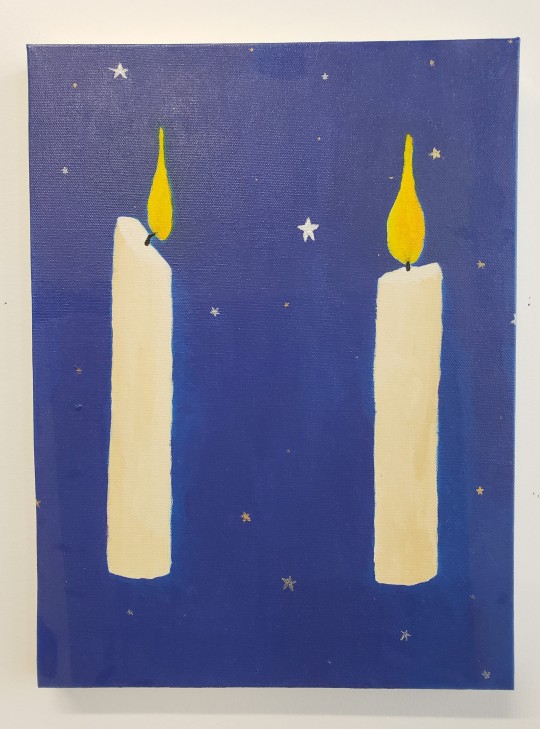
(The Lovers)
#washington dc#dc#dc metro area#hyattsville#maryland#colin o'brien#catholic#catholic artist#catholic artist connection#artist#art#visual art#visual arts#painting#benedictine#benedictine oblate#Leo Feroleto#six summit gallery#leo house#catholic artists nyc#manhattan#chelsea#ukranian catholic#philadelphia#st. jerome#st. jerome's parish#st. anselm's abbey#Dominican House of Studies#dominican#shrine of the holy family
1 note
·
View note
Quote
[H]istorians for years have remarked the curious dialectic within American culture, between its indigenous Protestant roots and the image of European, therefore foreign, Catholic culture. As T.J. Jackson Lears demonstrated almost three decades ago, this dialectic manifested itself most plainly in the neo-gothic church architecture of the late nineteenth century. Protestant churchmen during this period sometimes attributed the decline of their denominations to the austerity of Protestant liturgy and the cultural hortus siccus their doctrines seemed to germinate. They therefore sought to reformulate that culture through a series of aesthetic borrowings from Catholic Europe. The use of stained glass in church decoration, the appearance of liturgical choirs capable of chanting with the best of the Benedictines, have their source in this borrowing. But, the raising of neo-gothic bell towers over Presbyterian, Episcopal and Methodist cornerstones, for very practical reasons has proven the most enduring such phenomenon. In my old neighborhood in South Bend, Indiana, I could walk to two very nice Catholic churches, one drawing on Italian renaissance architectural traditions, the other on American colonial. If I walked only two blocks on, I would run across an Evangelical church whose squat, haunting stones looked almost more medieval than Notre Dame de Paris, and a Methodist Church designed to seem more ancient than the conscientiously modern sect occupying it. These buildings represent an attempt to borrow a form of beauty related to, but in practice radically suspicious of, the ideas of the good and the true that subsist in Catholicism.
James Matthew Wilson, “Orders of the Analogical Imagination: An Introduction to Catholicism and Modern American Poetry”
#james matthew wilson#art and catholicism#church architecture#500 reasons and counting#dappled things#architecture
6 notes
·
View notes
Text
Written statement
While the candle is used in many religious and cultural celebrations, the candle is also lit for many reasons; to relax and create ambiance, the scent that emerges and for decorative reasons (Melt, 2017). According to Snow (2021), the warmth of the candle also holds symbols of love and support whilst the light creates a sense of optimism and symbolises light, truth and knowledge. The birthday tradition of the lighting and blowing out of candles to make a wish is also a significant role in which the candle plays, and dates back meany years where people believed smoke took one’s prayers to the heavens to be heard and answered (Melt, 2017).
The first image highlights the use of a candle for decorative and functional purposes. Inspired by photographer Paulette Tavormina, this image encapsulates an essence of Dutch still life paintings. To portray this, I particularity focused on using dark tones and natural elements of wood and flowers. The use of flowers not only adds a natural element, but also an element of contrast to the image and symbolises life and growth. To create a more somber mood, I used artificial light, as it enabled me to have more control and create more depth to the image. The textural element of the wood background, adds an element of roughness to the image to contrast against the elegant candle and flowers.
A religious setting is portrayed in the second image, where those of the Catholic faith, the flame holds a somber and sacred meaning and is lit at the beginning of each mass to represent the illumination of Christ (Melt, 2017). The candle has played a significant role in religious and spiritual settings since the candle was invented (Everything, 2008). The mood captured in this image is symbolic, serious, yet enlightening. I used natural diffused light, to create a soft quality and to enable the stained glass window to be the dominant feature alongside the candle. The props used of the bible, cross and stained glass window, support the religious setting and help set the scene. The illuminated stained glass window, projects a sense of hope and enlightenment and contrasts against the soft tone of the image.
The third image reflects a soft, dream-like and calming mood Inspired by photographer Carl Ostberg and his use of coloured hues and floral arrangements to create an ethereal aesthetic. To reflect this mood I used direct natural light to create an airy and light tone as well as adding a textural element through the use of shadows. This image reflects the use of the candle for relaxation and calming purposes, which is a current popular function of candles nowadays, particularly those which are scented. According to Living Light (2020) this is because candlelight is gentle and soft on the eyes. The warm softness of a candle flame, enables the mind to focus and concentrate better (Living Light, 2020). The background of a sky supports the dream-like mood of the image and symbolises the idea of freedom and imagination (Symbolism and Metaphor, n.d.). A pink hue was added to the image to add a calming and soft tone to the image and the props of the flowers and orange support the calming mood as well as adding a scented element.
References
Melt. (2017, January 13). Honour, Passion And Celebration: The Role Of Candles In Religion. https://www.themeltco.com/blog/role-of-candles-in-religion/
Snow, E. (2021, March 21). 10 Common Symbols in Still-Life Paintings & What They Mean. https://www.thecollector.com/still-life-paintings-what-they-mean/
Everything. (2008, December 6). Role of Candles in Religion. https://everything2.com/title/Role+of+Candles+in+Religion
Symbolism and Metaphor. (n.d.). Sky Symbolism (11 Top Meanings). https://symbolismandmetaphor.com/sky-symbolism/
Living Light. (2020, June 26). Why do we love candles so much? https://www.livinglightcandles.co.nz/blogs/journal/spring-cleaning-checklist
0 notes
Text
Resurrection

Above the refrigerator, in a cabinet barely accessible unless you take out the step ladder, Easter resides. If I want to be religiously metaphoric, it might be a tomb, from which, once a year memories are resurrected.
Four dozen-cartons hold fragile shells, painted and drawn and dyed, hollowed out years ago and filled, for so many afterwards with Cheerios, nuts, jellybeans, and chocolate. Open a papier-mâché egg to find another inside and inside that a fuzzy chick with wonky wire legs. As the plastic grass falls out, so does the past.
Easters then were like Christmas eves, but outdoors and in the daylight, and we went to church before, not after, the events at La Vista Place. The cast of characters for these included as one might expect, aunts, uncles, cousins, but there were also “aunts” and “uncles” that then and even now I didn’t understand who they were or why they were given the moniker, as though they were related. As teens we privately dubbed one “creepy Frank” — his hair and mannerisms unnerved us as we were conscious of our own hair and mannerisms and I wonder if in our apprehensions we were cautious or just cruel. Perhaps we didn’t really know what to make of “Frank” as the rest had more fanciful names: Ulric, (2 of those), Evelyn, Bannister, Willis (2 of those), Eugenia, Stuart, Lourinda, Georgianna, Alma. For a while there was a Nancy, but her normalcy did not last in marriage to the eccentricity of Bannister (but that’s long and sordid story). We had some Biblical names too: Martha, Judith, Paul—but certainly nothing too Catholic among the family; here if there was a Jesus, he was a gardener and Maria would be a housekeeper.
There were five of us children, dressed in absurd outfits—crisp dresses with new, white Mary Janes and a peculiar hat and/or pocketbook for the girls and ill-fitting suits or sailor suits for the boys—these costumes, worn likely just once—were memorialized on Kodachrome that over the years has aged so that not just our dresses are yellow.
But we were stars in a moving picture show. Grandpa captured it all on 16 mm film, first in black and white and later in scratchy color. Before there was video and streaming and tiktok we had moving pictures and could subject family and friends occasionally to watch, but otherwise the celluloid lay neatly coiled in silver boxes, stacked in the hall closet, remote memories accumulating for later generations to likely assign to the heap. But if you were to find the means to project these crinkly images on a screen, you would see five children, feverishly looking in hedges, under rose bushes, amid the fronds of ferns, along the crevassed curve of the driveway curb to find hollowed out eggs, painted like stained glass by Lourinda, filled with Cheerios and jelly beans. You’d see bodies converge and diverge, in herky jerky motions of erratic action exaggerated by the medium; you’d see heads turn in response to a voice calling that you can’t hear. And then you’d see a shift in focus, an intensity of search that meant it was time for the highlight of the hunt: gold and silver, hard boiled and spray painted. Harder to locate, adults could join this hunt, for it took years of practice to succeed and the prize sweeter than treats: $20 for the gold, $10 for the silver.
I remember one year finally finding the gold, and after that it seems the memories at La Vista Place vanish. We had grown up and then grandpa died.
When we really grew up and had our own children, the tradition was reborn. And now those children too have grown, and so those cartons of eggshells wait, like the circular tins of celluloid, for the promise of resurrection.
April 4, 2021
0 notes